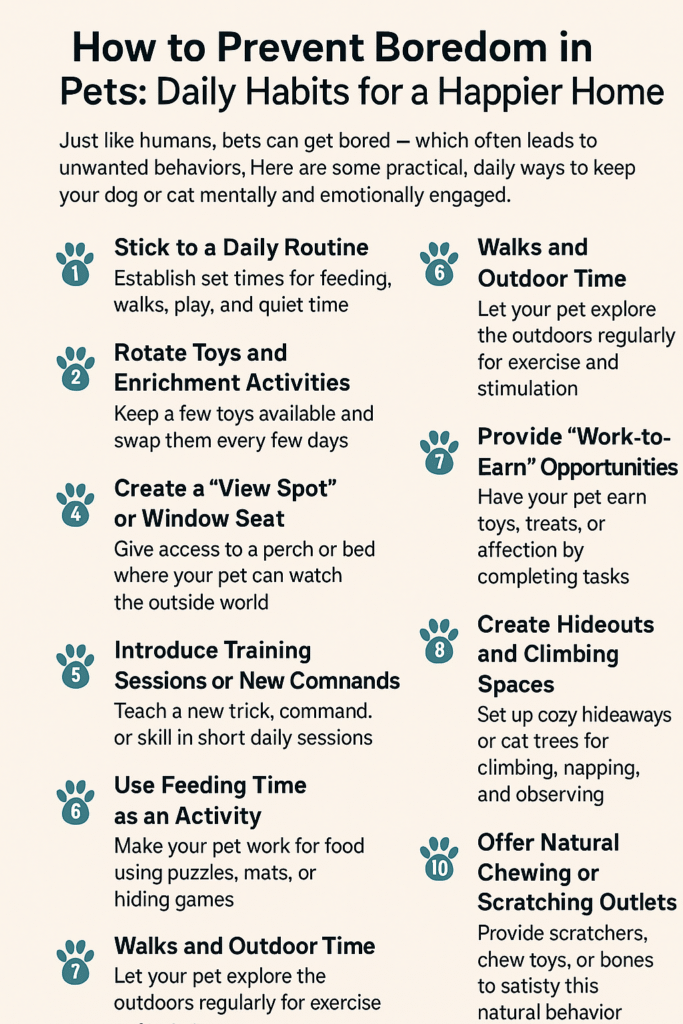Just like humans, pets can get bored — and when they do, it often leads to unwanted behaviors. Chewed furniture, scratched doors, excessive barking or meowing, and even depression can all be signs of a bored pet craving mental stimulation and physical activity.
In this article, you’ll learn practical, daily ways to keep your dog or cat mentally and emotionally engaged, prevent boredom, and improve their overall happiness at home.
Why Pets Get Bored (Especially Indoors)
Whether you’re a busy professional or spend most of your day at home, pets need structured interaction and stimulation. When they don’t get enough of either, they may develop:
- Destructive habits
- Excessive sleeping or inactivity
- Aggression or anxiety
- Overeating or lack of appetite
- Attention-seeking behavior
Boredom in pets is real — and preventable.
Signs Your Pet Might Be Bored
Here are a few clear signs that your dog or cat isn’t mentally stimulated enough:
- Following you around constantly
- Digging, chewing, or scratching inappropriate items
- Restlessness or pacing
- Barking or meowing without reason
- Sleeping excessively
- Lack of interest in usual toys or games
If your pet shows several of these signs, it’s time to shake things up with new routines.
Daily Habits to Prevent Boredom
1. Stick to a Daily Routine
Pets thrive on predictability. Establish a schedule that includes:
- Set times for feeding, walks, and play
- Consistent quiet time and bedtime
- Regular grooming and training sessions
Routine helps pets feel secure — and gives them things to look forward to.
2. Rotate Toys and Enrichment Activities
Don’t leave all toys out at once. Instead:
- Keep 2–3 toys available per day
- Swap them every 2–3 days
- Reintroduce older toys weekly to renew interest
Add puzzle toys, treat-dispensing balls, or catnip toys to add excitement.
3. Create a “View Spot” or Window Seat
Give your pet access to a window where they can watch birds, people, or nature.
- Use a cat window perch
- Set a dog bed near a safe glass door
- Leave the blinds open (if safe)
This gives pets something to observe during quiet hours.
4. Introduce Training Sessions or New Commands
Mental exercise is just as tiring — and beneficial — as physical exercise.
- Teach one new trick or command per week
- Use short, 5-minute daily sessions
- Reward with praise or small treats
Cats can learn, too! Try clicker training or teaching them to high-five.
5. Use Feeding Time as an Activity
Don’t just place food in a bowl — turn it into a game:
- Use a food puzzle or slow feeder
- Scatter kibble on a snuffle mat or towel
- Hide small amounts in different rooms (supervised)
This stimulates natural foraging instincts.
6. Walks and Outdoor Time
For dogs: Aim for at least 30–60 minutes of outdoor activity each day.
For cats: Try leash training, supervised balcony time, or a secure “catio” (cat patio).
Fresh air and new scents offer excellent stimulation.
7. Provide “Work-to-Earn” Opportunities
Have your pet “earn” treats, toys, or cuddles by completing tasks or behaviors like:
- Sitting calmly
- Waiting before meals
- Touching a target
- Fetching a toy
This turns everyday moments into mentally stimulating challenges.
8. Create Hideouts and Climbing Spaces
Especially for cats (and small dogs), having private spaces or vertical environments prevents boredom and stress.
- Use cat trees, hammocks, or wall shelves
- Provide cozy blankets in quiet corners
- Allow access to safe rooms they can explore
Changing up the layout occasionally keeps things fresh.
9. Play Together Every Day
You are your pet’s favorite toy. Even just 10–15 minutes of daily interaction can:
- Strengthen your bond
- Improve their mood
- Reduce separation anxiety
- Tire them out for better sleep
Use feather wands, balls, or simple games like tug-of-war.
10. Offer Natural Chewing or Scratching Outlets
- For dogs: Durable chew toys, raw carrots (under supervision), frozen treat toys
- For cats: Cardboard scratchers, sisal posts, or vertical scratching towers
Redirect chewing or scratching energy toward the right objects — not your couch.
What NOT to Do When Pets Are Bored
- Don’t punish destructive behavior — redirect it with stimulation
- Don’t leave them isolated for long periods without interaction
- Don’t rely solely on treats to entertain (can lead to weight gain)
- Don’t expect toys to replace human time — nothing beats quality attention
Special Considerations for Different Pets
High-Energy Dogs:
- Require more exercise AND mental challenges (scent games, agility, etc.)
Older Pets:
- Enjoy shorter play sessions, gentle massages, and calming enrichment like soft music or food toys.
Shy or Anxious Pets:
- Benefit from safe zones, quiet enrichment, and soft-spoken interaction.
Final Words: A Stimulated Pet Is a Happy Pet
Preventing boredom isn’t about overwhelming your pet with nonstop activities — it’s about offering meaningful engagement, a balanced routine, and space to express their natural instincts.
By committing to small daily habits, you’ll help your pet feel fulfilled, loved, and at peace in their environment — every single day.
